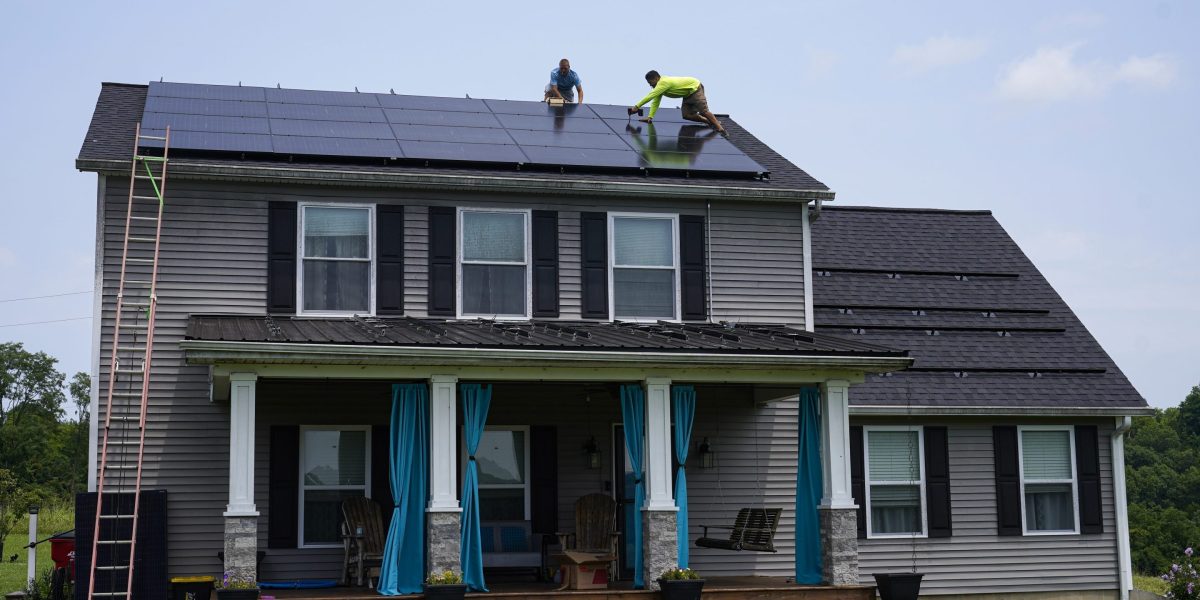Solar rooftops gain traction as electric vehicles owners look to skip paying for electricity or gasoline: ‘Solar just makes sense’::Residential solar is gaining traction in the U.S., with about 4.5 million homes now with solar rooftops.
Too bad this is for a person that:
- has enough income to afford an EV
- has a house.
- has enough income to afford the initial cost of the solar panels and installation.
Sadly most dont
"4. Doesn’t live with an HOA that has banned solar roof panel installation (Source: My parents HOA in South Carolina)
Pretty sure that’s illegal.
Edit: Depends on the state.
https://www.cnet.com/home/energy-and-utilities/you-can-get-solar-panels-even-in-an-hoa-heres-how/
In many cases the cost of a loan for solar panels is roughly equivalent to your monthly electric bill. I actually spend less on my loan than I did with the utility company. Of course you have a valid point overall, but I bring this up because many people are not aware that the cost difference can be pretty minimal or even to your benefit.
You can also buy just the panels and install them yourself if youre handy. They are generally just rails you bolt to a support beam in your roof. Mount the rails, water seal the penetration points, rack the panels, plug one into another, drill and seal an ingress hole for the wiring.
Instead of paying 30-40k for an installer to do it all, you can likely pay 5-10k for panels/inverters/tie in box and another 5k for an electrician to wire it all in.
Okay, but unless you have a proper harness and other safety equipment, you face a heavy risk of severely, likely permanently, injuring yourself if you slip up.
Hmmm I wonder if I still get the rebates if I diy it. Ah well, I suppose it doesn’t matter until the two maples in front of my neighbor’s house fall down.
You still have to buy the panels/etc. i dont see why they wouldn’t apply, but I haven’t done it yet so I can’t answer that unfortunately.
This is all true, and yet it’s still a good thing.
The more people invest in this stuff the cheaper it will get.
Putting panels on roofs is the most expensive way to do solar, anyway. It’s a custom job every time, and doesn’t take advantage of economies of scale.
Putting them in big fields is far cheaper. If you want to stick it to traditional power utilities, then look at community solar.
So what? Who owns a giant field to put them in other than power companies? If you own your home and own the panels, that’s your power. Even if it’s not enough to get off the grid entirely, you’re still saving money.
Also you need to keep them clean to maintain efficiency. In a field that’s easy - you can probably just employ the landowner and buy an attachment for his tractor. On the roof there isn’t really any good way of automating it, and some rooftops aren’t accessible for a window washer and a long brush.
I could probably afford one of the panels to keep in my apartment until I’m evicted.
This is the best summary I could come up with:
Less than a year later, motivated to take more action to address climate change, he said, Selgo bought his first electric vehicle, a Nissan Leaf.
It’s an important point because electricity production and transportation are the largest two sources of greenhouse gas emissions, and therefore climate change, in the U.S., according to the Environmental Protection Agency.
Several legacy car companies are launching efforts to connect customers with energy services, including solar installation contractors.
About half of households in the U.S. either don’t have control over their roof, or find that it’s not adequate because of location, space or orientation, according to the DOE solar office.
The Inflation Reduction Act, which President Joe Biden signed into law in August 2022, allows consumers to claim 30% of what they put into their system as a credit on their next federal tax bill.
Selgo said his system cost $19,500, but after receiving the 30% federal tax rebate and $1,000 from the state of Arizona at the time, he ultimately paid out around $12,500.
The original article contains 886 words, the summary contains 168 words. Saved 81%. I’m a bot and I’m open source!
Electric vehicles use a huge amount of power that many solar systems may not be able to accommodate, in addition to the regular usage load of the house. Keep in mind that the electrification dream is to also run HVAC and hot water off of electricity too. Also, in terms of charging your car, you’ll usually be at home charging overnight when the sun isn’t out. Sure, you can install a battery to charge from, but the capacity of these power walls is puny compared to the needs of an electric car. Also, you may want to use some of it for your actual house.
Not saying we shouldn’t try at home solar or that it won’t work for some folks, but it’s not a silver bullet. A lot of people will still be drawing from the grid, even with solar and back up batteries.
Fast-charging an EV for an hour would use the same amount of electricity a home would likely use in a day.
The government should use satellite imaging to locate all the rooftops and parking lots most suitable for photovoltaic panels and lease those spaces from the property owners to install them. The generated electricity would belong to the government to sell to the grid, but the property owners would be allowed to use the panels for backup power if they get disconnected from the grid because bad weather and whatnot. Anyone that declines the offer gets taxed on the imputed rent.
Nah. Solar as a govt project only makes sense as a solar farm. Much less expensive, easier to maintain, and doesn’t piss off your voters.
Rooftop solar makes sense as a government project because it increases resilience and does something productive with all that otherwise wasted surface area. Also, as a homeowner, a government run rooftop solar program like what I suggested would piss me off a lot less than what we have now, what with the scammy private solar contractors and inscrutable “incentive” programs.
Unless the property owner is managing maintenance etc. directly themselves, it would be a herculean task to support and maintain thousands of small installations spread out across the country instead of a handful of solar farms.
Maintenace and repairs can be managed through the utility companies, which already do so for many pieces of hardware on their customers’ properties just fine. The government might also offer property owners a higher payment if they accept certain responsibilities.
Maybe it’s different in the US, but where I live the utility company only services the main fuse that supplies the property. Everything else is done by electricians paid for by the owner.
Where I live in New Jersey, the utility company not only owns and services the meters, it also leases, sells, and services various home appliances, like furnaces and water heaters.
Rooftop solar means managing hundreds of small installations. You need every one of them to have small inverters instead of one big one. Each of those installations will be a custom job to fit it to the roof. You will likely need to upgrade your electrical service, as well, typically from 100A to 200A. The first few people in the neighborhood can do that, but as soon as everyone does it, the power company needs to upgrade the lines coming in.
Rooftp residential solar is the worst, most expensive way to do it.
Having enough land for solar is not a problem. With the amount we use on raising beef cattle, eating a few less burgers a week would open up plenty of land. Even without that, there’s plenty of dual-use ideas for covering parking lots, roads, irrigation canals, and even some types of farming.
Custom installations are good because it means more trade jobs and having to upgrade the power lines doesn’t seem that bad compared to building new infrastructure, including roads, in order to support large scale remote installations. Furthermore, distributed rooftop solar better equips the public to handle grid failures.
As for the cattle, even if we ever manage to liquidate all of them, it’s probably better to put their former pastures to some other type of agriculture or reforestation rather than cover it all with photovoltaics.
This. I haven’t pulled the trigger on solar because I don’t know which company to trust and I am not confident any of them will be around to repair or upgrade the equipment in a few years.
There’s some benefit to having it closer to where people live, but yes it would make more sense on a larger area in one spot (ex. Government owned school rooftop or parking lot)






